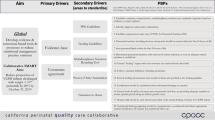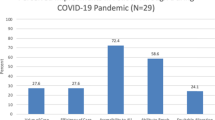Abstract
Providing safe and effective care requires coordination among the multiple levels of the health care system. These levels comprise the newborn (patient, family and community), nursery or primary care practice (microsystem), hospital or managed care organization (macro-organization) and policy, payment or regulatory issues (environmental context). Contemporary care practices associated with childbirth and early newborn care often reflect disruptions in coordination of these processes and place newborns at risk for poor outcomes. For example, with routine early postpartum discharge, often at less than 48 h after vaginal birth, the peak of serum bilirubin at 3 to 5 days of age typically occurs at home, rather than observed by clinicians in a newborn nursery. In addition, lactation is rarely well established by early discharge and support is often inadequate, increasing the risk of hyperbilirubinemia and discontinuation of breastfeeding. Also, late preterm infants are frequently cared for in the newborn nursery, although they often have difficulty establishing oral feeding and are at substantially higher risk for severe hyperbilirubinemia than infants born at term. Finally, pediatric follow-up is often delayed beyond the first week, after the optimal time for continued assessment of jaundice and lactation. The American Academy of Pediatrics Safe and Healthy Beginnings Initiative, a pilot quality improvement project, will target newborn nurseries, primary care practices and coordination between these sites using a systems-based approach to facilitate implementation of the 2004 guideline for management of hyperbilirubinemia.
This is a preview of subscription content, access via your institution
Access options
Subscribe to this journal
Receive 12 print issues and online access
$259.00 per year
only $21.58 per issue
Buy this article
- Purchase on Springer Link
- Instant access to full article PDF
Prices may be subject to local taxes which are calculated during checkout



Similar content being viewed by others
References
Ebbesen F, Andersson C, Verder H, Grytter C, Pedersen-Bjergaard L, Petersen JR et al. Extreme hyperbilirubinaemia in term and near-term infants in Denmark. Acta Paediatr 2005; 94: 59–64.
Manning D, Todd P, Maxwell M, Platt MJ . Prospective surveillance study of severe hyperbilirubinaemia in the newborn in the United Kingdom and Ireland. Arch Dis Child Fetal Neonatal Ed 2007; 92: F342–F346.
Yamauchi Y, Yamanouchi I . Breast-feeding frequency during the first 24 hours after birth in full-term neonates. Pediatrics 1990; 86: 171–175.
De Carvalho M, Klaus MH, Merkatz RB . Frequency of breast-feeding and serum bilirubin concentration. Am J Dis Child 1982; 136: 737–738.
Gartner LM, Morton J, Lawrence RA, Naylor AJ, O'Hare D, Schanler RJ et al. Breastfeeding and the use of human milk. Pediatrics 2005; 115: 496–506.
Riordan J, Bibb D, Milller M, Rawlins T . Predicting breastfeeding duration using the LATCH breastfeeding assessment tool. J Hum Lact 2001; 17: 20–23.
Hall RT, Mercer Am, Teasley SL, McPherson DM, Simon SD, Santos SR et al. A breast-feeding assessment score to evaluate the risk for cessation of breast-feeding by 7 to 10 days of age. J Pediatr 2002; 141: 659–664.
Labarere J, Gelbert-Baudino N, Ayral AS, Duc C, Berchotteau M, Bouchon N et al. Efficacy of breastfeeding support provided by trained clinicians during an early, routine, preventive visit: a prospective, randomized, open trial of 226 mother–infant pairs. Pediatrics 2005; 115: e139–e146.
Berwick DM . A user's manual for the IOM's ‘Quality Chasm’ Report. Health Aff 2002; 21: 80–90.
Salem-Schatz S, Peterson LE, Palmer RH, Clanton SM, Ezhuthachan S, Luttrell RC et al. Barriers to first-week follow-up of newborns: findings from parent and clinician focus groups. Jt Comm J Qual Saf 2004; 30: 593–601.
Palmer RH, Clanton M, Ezhuthachan S, Newman C, Maisels J, Plsek P et al. Applying the ‘10 simple rules’ of the institute of medicine to management of hyperbilirubinemia in newborns. Pediatrics 2003; 112: 1388–1393.
American Academy of Pediatrics Committee on Fetus and Newborn. Hospital stay for healthy term newborns. Pediatrics 2004; 113: 1434–1436.
Ward KE, Pryor RW, Matson JR, Razook JD, Thompson WM, Elkins RC . Delayed detection of coarctation in infancy: implications for timing of newborn follow-up. Pediatrics 1990; 86: 972–976.
Bernstein H, Spino C, Finch S, Stoltz R, Stark A, Woo H et al. Inadequate attention given to jaundice in healthy term infants during the first postpartum week. Pediatr Res 2004; 55: 282A.
Stark AR, Profit J, Cambric-Hargrove AJ, Tittle KO . Delayed pediatric office follow-up of newborns following birth hospitalization. E-PAS 2007: 617934.21.
Davis D, O'Brien MA, Freemantle N, Wolf FM, Mazmanian P, Taylor-Vaisey A . Impact of formal continuing medical education: do conferences, workshops, rounds, and other traditional continuing education activities change physician behavior or health care outcomes? JAMA 1999; 282: 867–874.
Jamtvedt G, Young JM, Kristoffersen DT, O'Brien MA, Oxman AD . Audit and feedback: effects on professional practice and health care outcomes. Cochrane Database Syst Rev 2006 CD000259.
Margolis PA, Lannon CM, Stuart JM, Fried BJ, Keyes-Elstein L, Moore Jr DE . Practice based education to improve delivery systems for prevention in primary care: randomised trial. BMJ 2004; 328(7436): 388.
Rogers EM, Rogers E . Diffusion of Innovations, 5th edn. Free Press: New York, NY, ISBN 0-7432-2209-1 2003.
Subcommittee on Hyperbilirubinemia, American Academy of Pediatrics. Clinical Practice Guideline: management of hyperbilirubinemia in the newborn infant 35 or more weeks of gestation. Pediatrics 2004; 114: 297–316.
Boushon B, Provost L, Gagnon J, Carver P . Using a virtual breakthrough series collaborative to improve access in primary care. Jt Comm J Qual Patient Saf 2006; 32(10): 573–584.
Langley GL, Nolan KM, Nolan TW, Norman CL, Provost LP . The Improvement Guide: A Practical Approach to Enhancing Organizational Performance. Jossey-Bass Publishers: San Francisco, California, USA, 1996.
Author information
Authors and Affiliations
Corresponding author
Rights and permissions
About this article
Cite this article
Stark, A., Lannon, C. Systems changes to prevent severe hyperbilirubinemia and promote breastfeeding: pilot approaches. J Perinatol 29 (Suppl 1), S53–S57 (2009). https://doi.org/10.1038/jp.2008.215
Published:
Issue Date:
DOI: https://doi.org/10.1038/jp.2008.215
Keywords
This article is cited by
-
The gas cylinder, the motorcycle and the village health team member: a proof-of-concept study for the use of the Microsystems Quality Improvement Approach to strengthen the routine immunization system in Uganda
Implementation Science (2015)
-
Clinical report from the pilot USA Kernicterus Registry (1992 to 2004)
Journal of Perinatology (2009)



